Six Steps to a Successful Seeding
Guidelines for large areas (greater than about 1,000 square feet):
- Time to establish from seed: 3-5 years
- For best results, consult with a native plant producer before selecting plant species for your planting.
Step 1: Select a site
Native plants will be damaged by herbicide drift, so be sure the location will not have drift. Prairie plants need at least six hours of full sun daily, and plants will not do well on a north-facing hillside. Native plants can establish and thrive in areas that fit these requirements and can be accessed for maintenance. If you plan to use fire to manage your native planting, do not plant near conifers and include fire breaks in the design.
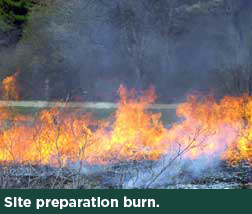 Step 2: Prepare the site
Step 2: Prepare the site
Eliminate existing plants using one or a combination of the following:
- Apply herbicide. Glyphosate may be applied at 6-8 week intervals and 1 week before seeding.
- Burn. Shrubby sites with adequate firebreaks can be cleared by burning.
- Cultivate. Ideal for large sites, in locations that are not burnable, and for those who do not want to use herbicide.
- Smother. This works well in areas of less than 1000 ft²
Do not neglect this step or the planting will have little chance of success. The ideal preparation time will vary from several weeks to 1-2 years depending on previous land use.
Step 3: Analyze your site
Determine soil type (sand, silt, clay, muck), drainage, moisture, slope, and amount of sunlight. Take a soil sample and test for pH and organic matter. Neither a droughty, infertile subsoil nor a tight wet clay soil is suitable for many wildflower species.
Seeding is most successful in spring (mid-May to mid-June) or late fall (mid-October through November). Overseeding and seeding into areas with dead vegetation are most successful in winter when there is no snow cover (November through February).
Step 4: Select proper plant species for your site
With information about your site, you can choose plant species that are likely to establish well in site conditions. Choose wildflower/grass species for a permanent planting that are perennial, native to Michigan, and grown as close to your area as possible for better adaptability. Select a variety of plants that will bloom throughout the growing season. If you have a site with high erosion, you may need to sow a cover crop for quick cover.
 Step 5: Prepare the seedbed, sow, and incorporate seed into soil
Step 5: Prepare the seedbed, sow, and incorporate seed into soil
Prepare the seedbed by raking, cultivating, or burning, so that about 50 percent of the soil surface is showing. Removing all dead vegetation is not necessary. Scarify (loosen or stir) the soil surface with rake, thatcher or carefully controlled tiller to a depth of one inch. Avoid turning up new soil, as this will bring new weed seeds to the surface. Roll prior to seeding to firm the seedbed. Standard seed drills for crop seeds will not be effective at seeding because seeds range greatly in size and shape, from less than 1/16 inch to 1/4 of an inch long.
You may use any of the following methods according to the area to seed, the equipment available to you, and the result you desire. Each has unique benefits and drawbacks.
- By hand. A carrier such as moist sawdust or vermiculite increases evenness. Hand-cranked whirlwind seeder.
- Mechanical seeder. Either a drill or drop seeder; drill seeders may be adapted for no-till planting into dead vegetation, drop seeders require cultivated soil.
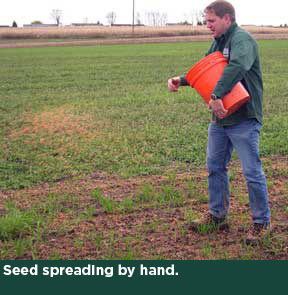
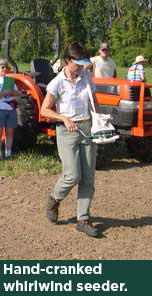
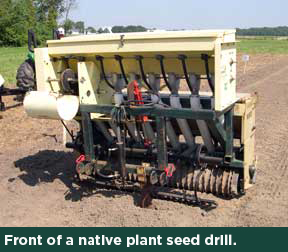
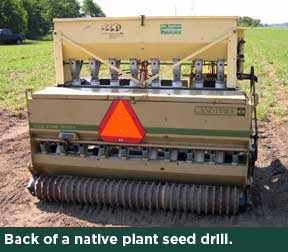
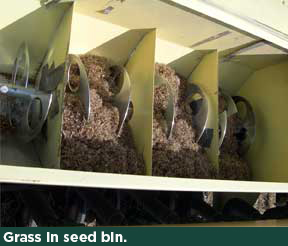
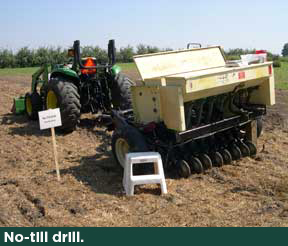
Criss-cross the seedbed several times to spread the seeds evenly. Seeds may be planted as a homogeneous mix or choose several species to seed separately. Sow the wildflower/grass mix over the entire plot.
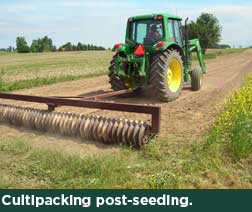 Seed to soil contact is vital for good germination and seed survival. Incorporate seeds by raking very lightly or going over the area with a thatcher. Seed should be covered no deeper than its own diameter. Bare, erosive soil should be mulched with oat straw so that 50% of the soil still shows. A final critical step is to roll with lawn roller or cultipacker, or tamp small areas with rake or foot.
Seed to soil contact is vital for good germination and seed survival. Incorporate seeds by raking very lightly or going over the area with a thatcher. Seed should be covered no deeper than its own diameter. Bare, erosive soil should be mulched with oat straw so that 50% of the soil still shows. A final critical step is to roll with lawn roller or cultipacker, or tamp small areas with rake or foot.
Step 6: Management
First year management
Watering is not necessary but will speed germination and establishment in spring seedings. However, once watering is begun soil must be kept moist continuously until the seedlings are well established.
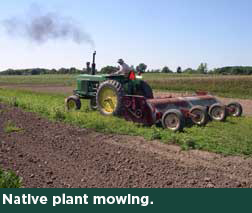 In the second season, mowing at 6-12 inches may be required 1-2 times, depending on weed pressure.Weeds may be a challenge the first year. A mowing regime for at least one year post planting helps control annual weeds. Cut the planting to 4-6 inches whenever growth reaches 10-12 inches during the first growing season. A string trimmer may be used on rough terrain or if mower cannot be set high enough. Plan to mow two to four times the first season.
In the second season, mowing at 6-12 inches may be required 1-2 times, depending on weed pressure.Weeds may be a challenge the first year. A mowing regime for at least one year post planting helps control annual weeds. Cut the planting to 4-6 inches whenever growth reaches 10-12 inches during the first growing season. A string trimmer may be used on rough terrain or if mower cannot be set high enough. Plan to mow two to four times the first season.
Long-term management
Beginning in the third year, the entire planting may be mown in late fall or early spring. If site location allows it, burning every three years in March or early April will help maintain a meadow planting. Do not burn the first two years as tender seedlings may be damaged. Be sure to obtain a burning permit or contact a professional. Long term management of a planting also begins in year two with weed pulling, cutting or spot spraying with herbicide.
 Please visit the following links for more information: Native Connections, Michigan Wildflower Farm, and Prairie Nursery.When well-established (3-5 years), wildflowers provide a relatively low-maintenance area with high aesthetic and environmental quality.
Please visit the following links for more information: Native Connections, Michigan Wildflower Farm, and Prairie Nursery.When well-established (3-5 years), wildflowers provide a relatively low-maintenance area with high aesthetic and environmental quality.



 Print
Print Email
Email